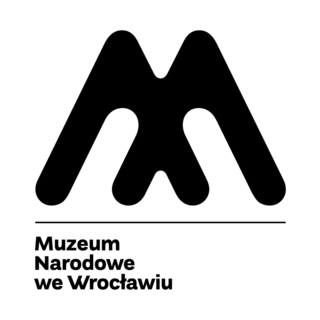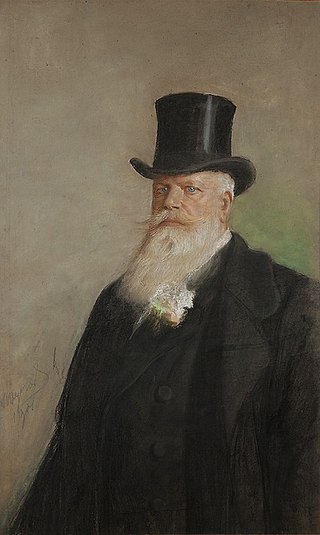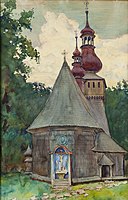
Jan Alojzy Matejko was a Polish painter, a leading 19th-century exponent of history painting, known for depicting nodal events from Polish history. His works include large scale oil paintings such as Rejtan (1866), the Union of Lublin (1869), the Astronomer Copernicus, or Conversations with God (1873), or the Battle of Grunwald (1878).

Jan Styka was a Polish painter noted for producing large historical, battle-piece, and Christian religious panoramas. He was also illustrator and poet. Known also as a great patriotic speaker - his speeches were printed in 1915 under the French title L'ame de la Pologne.

Stanisław Masłowski, born Stanisław Stefan Zygmunt Ludgard Masłowski was a Polish painter of realistic style, the author of watercolor landscapes.

Ignacy Aleksander Gierymski was a Polish painter of the late 19th century, the younger brother of Maksymilian Gierymski. He was a representative of Realism as well as an important precursor of Impressionism in Poland.

The Gallery of 19th-Century Polish Art at Sukiennice, is a division of the National Museum, Kraków, Poland. The Gallery is housed on the upper floor of the Renaissance Sukiennice Cloth Hall in the center of the Main Market Square in Old Town Kraków.

Artur Grottger was a Polish Romantic painter and graphic artist, one of the most prominent artists of the mid 19th century under the partitions of Poland, despite a life cut short by incurable illness.

Borys Voznytsky Lviv National Art Gallery is the largest art museum in Ukraine, with over 62,000 artworks in its collection, including works of Ukrainian, Polish, Italian, French, German, Dutch and Flemish, Spanish, Austrian and other European artists. The artwork is currently divided into three major collections, housed in the historic Lozynsky and Potocki Palaces, while the Gallery additionally has the charge of fifteen small museums and historical buildings in or close to Lviv.

The Constitution of 3 May 1791 is an 1891 Romantic oil painting on canvas by the Polish artist Jan Matejko. It is a large piece, and one of Matejko's best known. It memorializes the Polish Constitution of 3 May 1791, a milestone in the history of the Polish–Lithuanian Commonwealth and a high point of the Polish Enlightenment.

The Prussian Homage is an oil on canvas painting by Polish painter Jan Matejko painted between 1879 and 1882 in Kraków. The painting depicts the "Prussian Homage", a significant political event from the time of the Renaissance in Poland in which Albrecht of Hohenzollern, the Duke of Prussia paid tribute and swore allegiance to King Sigismund I the Old in Kraków's market square on 10 April 1525. Matejko depicted over thirty important figures of the Polish Renaissance period, taking the liberty of including several who were not actually present at the event.
Tomasz Jerzy Vetulani is a Polish painter, drawer and sculptor. Born and educated in Kraków, he moved to Utrecht in 1991, and he has been active there since, holding also a citizenship of the Netherlands. In his works, using among others silicone and sponge, he includes both personal references and comments on current political and social issues.

The National Museum in Wrocław, established 28 March 1947 and officially inaugurated on 11 July 1948, is one of Poland's main branches of the National Museum system. It holds one of the largest collections of contemporary art in the country.
Stanisław Grocholski was a Polish painter, active in Poland, Germany, and in the United States. He is the son of Antoni Rafał of the Syrokomla Coat of Arms.

Gustaw Gwozdecki was a Polish painter, sculptor, printmaker, and a representative of Post-Impressionist Kapists.

Władysław Wankie was a Polish painter and art critic. He painted realist landscape paintings, genre scenes, religious art and symbolic art. He was the co-author of the Panorama of the Tatra Mountains.

Wacław Wąsowicz was a Polish painter and printmaker.
Bolesław Jan Czedekowski was a Polish artist, who spent the vast majority of his life living abroad. Maintaining studios in Paris and Vienna, Czedekowski would spend a long career portraying high society on both sides of the Atlantic.
Józefat Ignacy Łukaszewicz was a Polish-Lithuanian painter.

Marian Szczyrbuła, was a Polish painter, a member of formism(polish expressionism) and of Polish Colourism.

Marcin Rożek was a Polish sculptor and painter and co-founder and professor at the School of Decorative Arts in Poznań. Rożek is most closely associated with the region of Greater Poland and the city of Poznań, in particular, although he was a well-established and highly regarded artist throughout Poland during the 1920s and 1930s.

Ignacy Karol Korwin-Milewski was a Polish-Lithuanian art collector, political writer and traveler.






















